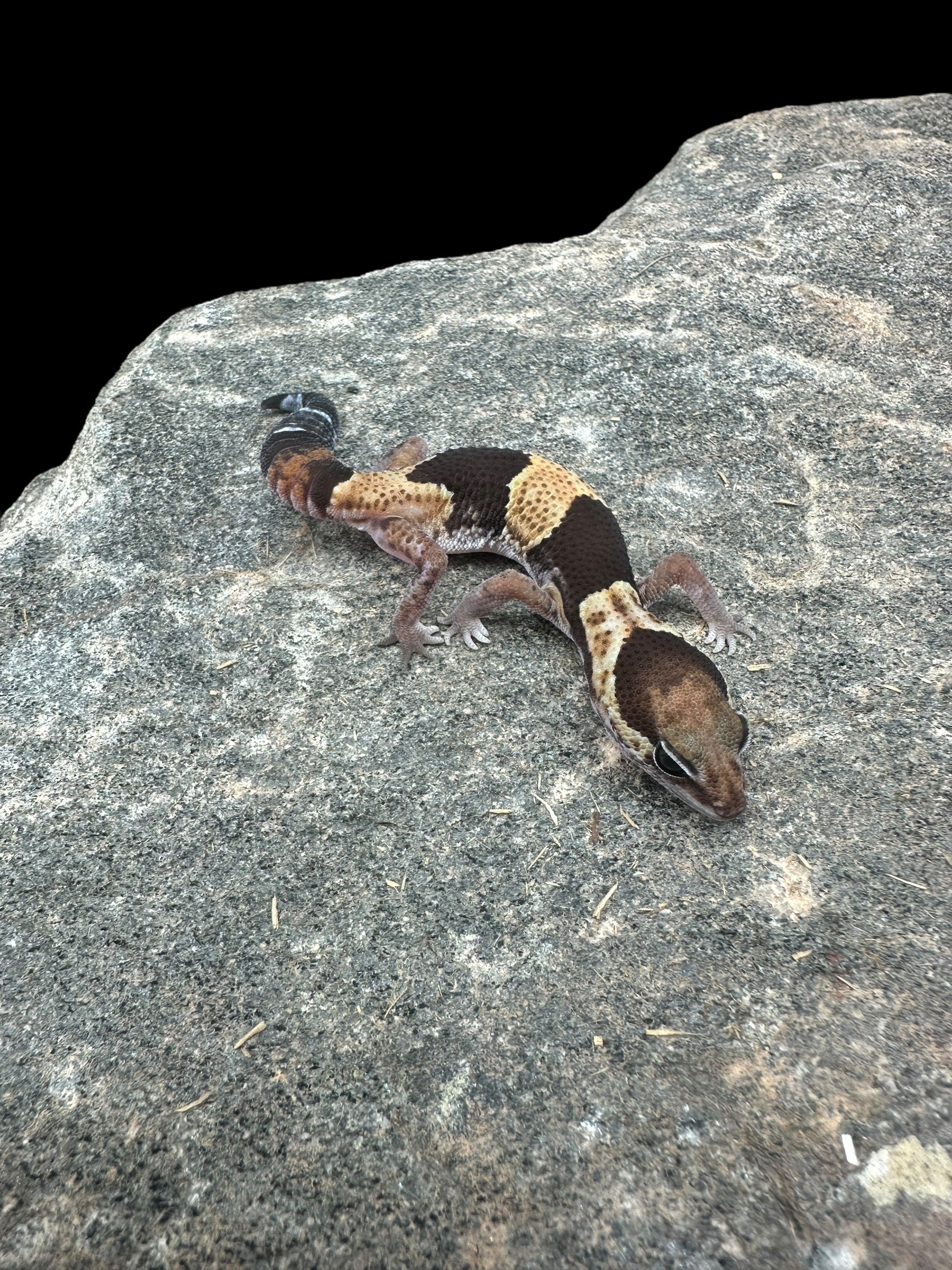Photo Disclaimer
Description
African Fat Tail Gecko (het. Caramel Oreo Zulu poss. het. Patternless)
Scientific Name: Hemitheconyx caudicinctus
Common Name: African Fat Tail Gecko
Species Overview
Size: Adult African Fat Tail Geckos typically reach 7–8 inches (18–20 cm) in length, with males being slightly larger and more robust. Their thick tails and soft, velvety texture make them distinctive among terrestrial geckos.
Appearance: The het. Caramel Oreo Zulu poss. het. Patternless African Fat Tail Gecko maintains the rich brown and tan banded appearance typical of the species, as none of the carried genes are visually expressed. This combination of recessive traits carries significant potential in breeding projects, as it may produce a wide array of striking visual offspring when paired appropriately.
Distribution: Native to West Africa, including Senegal, Ghana, Togo, Benin, and Nigeria, where they inhabit dry grasslands, rocky scrub, and savanna edges.
Habitat: Wild African Fat Tail Geckos reside in semi-arid zones, spending daylight hours within burrows or under stones to escape excessive heat. In captivity, they thrive in naturalistic terrariums that replicate this environment, using packed soil-sand mixes, stable humidity, and multiple hides.
Behaviour: Calm and deliberate, African Fat Tail Geckos are nocturnal and prefer dim lighting. They adapt quickly to captivity and are generally tolerant of handling once acclimated. Their slow-moving and inquisitive nature makes them excellent for observation.
Captive Care
Enclosure: An adult enclosure should measure at least 24 inches × 18 inches × 12 inches (60 × 45 × 30 cm). Naturalistic enclosures are recommended, featuring a compact soil-sand-clay substrate for burrowing and thermoregulation. Some keepers prefer reptile carpet, tile, or paper towel—especially for juveniles or during quarantine—to simplify cleaning and minimize ingestion risk. Include at least three hides: one on the warm side, one on the cool side, and one moist hide to assist with shedding.
Temperature & Humidity: Maintain a warm-side surface temperature of 88–92°F (31–33°C) and a cool side around 75–80°F (24–27°C). Nighttime temperatures can drop safely to 70–74°F (21–23°C). Humidity levels should remain between 50–70%, with a slightly damp hide provided for proper shedding.
Lighting: Though UVB lighting is not essential, a low-level UVB source (2–5%) supports natural activity and overall health. Maintain a consistent 12-hour light cycle.
Diet: Feed a rotating selection of crickets, dubia roaches, silkworms, and mealworms. Supplement with calcium and multivitamins on a regular schedule. Juveniles should be fed daily, while adults can be fed every 2–3 days.
Behaviour in Captivity: Known for their steady, predictable demeanour, African Fat Tail Geckos thrive with routine. They are rarely defensive and become quite docile with gentle handling.
Special Considerations: Always use thermostats on heat sources to avoid burns. Monitor tail thickness as an indicator of health and energy reserves.
Sand: Addressing Concerns and Misconceptions
Sand has been a debated substrate for geckos due to fears of impaction. However, when used as part of a compacted soil-sand blend and paired with correct heat gradients and proper nutrition, it poses minimal risk. The main issues occur with loose or calcium-based sands combined with poor husbandry. For hatchlings, juveniles, or animals in recovery, simpler substrates such as reptile carpet, tile, or paper towel are preferred until fully established.
Taxonomy Note
The African Fat Tail Gecko (Hemitheconyx caudicinctus) belongs to the Eublepharidae family, which includes eyelid geckos like the Leopard Gecko (Eublepharis macularius). Members of this group have movable eyelids and lack adhesive toe pads, making them fully terrestrial. This species is well-documented and displays stable variation throughout its West African range.
Genetics Note
Caramel (Recessive): Reduces melanin and alters pigment tone, producing lighter brown and tan coloration in visuals. When expressed, this gene gives geckos a warm, golden hue.
Oreo (Recessive): Intensifies dark pigmentation, producing near-black patterning in visuals. Often used to create dramatic contrast in combination morphs.
Zulu (Recessive): Alters the banding pattern into broken or irregular lines and spots, creating a highly distinctive appearance.
poss. het. Patternless (Possible Recessive Carrier): May carry the Patternless gene, which removes or drastically softens visible markings when expressed. Visual confirmation requires test breeding.
(“het.” is short for heterozygous, meaning one copy of the gene is carried but not expressed.)

